This post may contain affiliate links. If you make a purchase through a link, I may receive a small commission, at no cost to you. These commissions help keep this website up and running, and I thank you for your support. Read my full disclosure here.
Disclaimer: This is not a sponsored post. All recommendations are my own.
If you are beginner skier, then you are not likely to want to invest in expensive ski gear just yet. I recommend you try and borrow as much as you can like ski pants, goggles, helmet etc.. or even visit some second hand ski stores for some bargains. However, if you don’t have anyone to borrow gear off, then I’ve specified areas that you could either hire/ use a cheaper alternative/ or just do without.
Essential Tips to follow when packing for a Ski Trip
Before I get started on the packing list, I thought it would be helpful to go over some general packing tips that will make your life just that little bit easier.
-
- Luggage: Ski gear is bulky. We usually happily travel for several weeks with carry-on’s only. However, when my husband and I go skiing we usually pay for one checked in bag and share (to save money) this along with each of our carry-on’s is usually enough to accommodate everything.
- Packing Cubes: These packing cubes are a great way to keep your suitcase organised and tidy, they make it so much easier to find exactly what you need and fast.
- GoToobs: Cut down on your luggage by dispensing your products into these GoToobs They meet airline carry on regulations for liquids and are food-safe (FDA) and 100% BPA and PC-free. The no-drip valve stops them from getting messy and the squeezy tube design makes it easy to get the product out.
- GoTubbs: The makers of GoToob also make really clever little storage containers called GoTubbs which can be opened one-handed. They are great for storing jewellery, pills, and thick ointment.
- Laundry bag: I also use a laundry bag to keep dirty clothes separate from the clean ones. I like this bag because its not bulky. Also, it’s not transparent, so not embarrassing to carry to the launderette if you need to do some washing whilst on holiday.
- Toiletry bag: Read my post for some tips about what toiletries to pack and how pack a small toiletry bag.
Ski Gear
Day Bag
A good quality, comfortable day pack is essential for skiing so you can stash your supplies. Go for a small bag like this one because otherwise you will need to place it in front of you every time you get on the chair lift which will be annoying.
Ski Jacket
A warm windproof and waterproof jacket is essential. Don’t get too stressed about being colour coordinated and fashionable, just aim for functional. I recommend an insulated ski jacket like this one with hidden ventilation for the warmer days and wrist pocket to put your ski pass in. If you don’t have a waterproof jacket already but its not insulated, you can get away with wearing it if you wear lots of thermal layers underneath and good ski pants.
Tip
- It is handy if your jacket has a pocket on the arm to store your electronic ski pass. The ski pass will work through the coat pocket as you pass through the electronic gate, so you won’t need to take it out each time you get on the chair lift. However, if there is no pocket on the arm of the jacket, you can still make do with just using the normal normal pockets, you might just have to lift your jacket up a little to reach the scanner.
Ski Pants
A pair of windproof waterproof ski pants are an essential part of your kit. If you try and go skiing without ski pants, your trousers will get wet, especially as a beginner as you will likely fall over a lot, and it will make you incredibly cold!
Tip
- Wear a pair of thermal leggings under your ski pants to keep you toasty and warm.
Ski Gloves
There is nothing worse that having wet gloves, it will make you very cold, so get yourself some waterproof ski gloves. They may not be pretty, but the key is to keep warm and dry.
Warm Hat
Your hat needs to be firm fitting so it doesn’t fly off whilst you are whizzing down the ski slopes or up high on the chair lift. That’s why beanies are so popular on the ski field. Wear a warm wool hat like this one which has additional fleece lining for extra warmth and for comfort as it your head getting itchy from the wool.
For warmer, sunny days on the slopes, try a headband like this synthetic lined warm knitted headband. It’s stylish and perfect for keeping your ears toasty warm and hair out of your face. They are great for covering up messy hair as well.
Neck Gaiter
A neck gaiter or ‘buff’ is a closed tube of fabric that slips over your head to keep your neck warm. I prefer a neck gaiter made of warm fleece. When it’s really cold you can extend it up over your face. Another benefit is that unlike a scarf it is not as bulky so you can easily zip your jacket up with it underneath and it also won’t come unravelled and flap around. If you don’t want to invest in a neck gaiter and already have a warm infinity or cowl scarf, then you could use that.
Sports Bra
Ladies that need it – don’t forget to pack a good supportive, comfortable sports bra.
Thermals
Warm thermal tops and leggings are essential. My favourite wool thermals are from Ice Breaker – see me in my Ice Breakers thermals in the picture below. Full disclosure – they are a New Zealand brand so as a Kiwi I admit that I may be biased, but I think New Zealand merino wool is the best quality! They come in various weights for different levels of warmth, and unlike the polyester thermals, merino is both breathable and naturally anti-bacterial, it cleverly neutralises odour so you can get away with wearing them over many days without them getting stinky. The merino wool fibres are very fine, so they are softer and more flexible than standard wool, so don’t cause skin to itch. Ice Breaker also sell wool underwear, wool t-shirts (great when the weather is changeable), and outer layers like wool jumpers and hoodies. However, if you can’t wear wool, then skip down to my non-wool alternatives.
Thermal Tops & Singlets
I recommend you buy at least one long sleeve wool thermal like this one. If you really feel the cold like me, then wear a wool singlet underneath it too. A wool singlet won’t create further bulk around the arms (when you wear too many layers it can be hard to bend your arms!), but will add warmth to your core.
Thermal Leggings
Thermal leggings are essential for keeping your legs warm under your ski pants. I recommend these mid-weight wool thermal leggings, but if you really feel the cold, you might want to buy the heavyweight wool thermal leggings instead. If you are on a tight budget, then you could consider purchasing some cheaper 400 denier thick pantyhose.
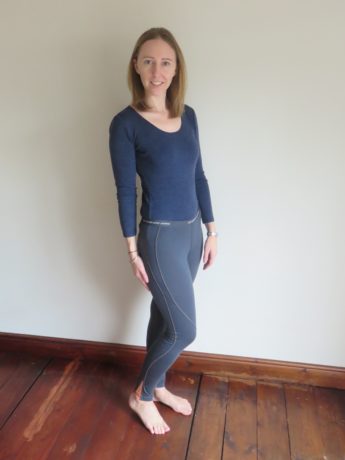
Non-Wool Thermal Alternatives
I don’t recommend cotton thermals, as they have a tendency to retain perspiration which can make you feel cold. If you cannot wear wool then try the Thermasilk range made of 100% silk. Although I haven’t tried them myself, they come highly recommended. They have a wide range of thermals including leggings, tops, socks and gloves. If you don’t wear animal products, then go for a good quality synthetic like this thermal set.
T-shirt
If it’s a warm day, and/or you have a very warm jacket, you may want to strip down to t-shirt underneath it or a t-shirt over your thermal.
Ski Socks
Ski socks are thicker and longer than your usual socks as they are designed to keep your feet and lower legs warm and comfortable as they will be in ski boots all day long. They should also be firm enough to stay up all day and not slide down and bunch up which will cause pressure points and blisters. I prefer these ski socks with wool to ensure warmth and to reduce the stink – you can save money by wearing the same pair several times. If you don’t wear wool, then here are some highly rated non-wool ski socks.
Mid Layers
On top of your thermals, you need to add more layers to keep you warm. Layers will allow you to stay comfortable as you can remove them when you get hot and add more when you get cold. Again, I love the Icebreaker mid-layers, especially the half zip or full zip with the neck collar because as I get hot I pull down the zip and collar to let in some cool air, but then when it gets chilly I can zip up and stay toasty warm. I like to pack an extra mid-layer in my day pack in case it gets really cold. For a non-wool version, go for a nice warm synthetic fleece.
Eyewear – Sunglasses or Ski Goggles?
Eye protection is an absolute essential on the ski field because snow is highly reflective of ultraviolet radiation. In fact, snow can reflect more than 80 percent of the UV rays that fall upon it. In addition, skiing takes place at relatively high altitudes, where the sun’s UV rays are stronger. When it comes to what to wear whilst skiing, you have two options for eye protection, either ski goggles or a good pair of sunglasses. Aim for a set of ski goggles like these that are anti-fog and have 100% UV protective lenses, or you could borrow some. Alternatively, a large pair of sunglasses will also suffice, however, they must provide 100% UV protection or UV 400 protection. That means that the glasses protect your eyes from both UVA and UVB radiation. Check the laws for your country, for example, in Australia and New Zealand all sunglasses sold must be tested and clearly labelled according to the Australian/New Zealand Standard for Sunglasses and Fashion Spectacles AS/NZS 1067. I do find that metal rimmed glasses can get really cold, so go for plastic if you can. I also prefer polarised sunglasses for better vision.
Make sure you pack some sunnies in your day pack for when your chilling at lunch time, because wearing goggles whilst eating isn’t very comfortable.
Ski Equipment & Items You will need for the Slopes
Skis/Snowboard, Bindings, Ski Poles, Ski Boots, and Helmet
Ski gear is expensive and transporting them will also create additional cost, whether that’s buying ski racks for your car or additional luggage costs for a flight. There is not much point in buying your own ski gear if you are skiing for the first time. However, I would caution against borrowing them because it is really important that the ski gear fits well, otherwise you will end up with some very painful blisters. I’ve seen lots of people get black toenails that fall off from poor fitting boots! For that reason, unless you know someone with a perfect fit, then I wouldn’t recommend borrowing them. Furthermore, experienced skiers usually have ski’s that are designed to be fast – something a beginner doesn’t need!
Therefore, I recommend hiring your ski gear. Ski rental is quite reasonably priced, and ski hire places usually provide beginner packs that include helmets, boots, bindings, skis, ski poles (however, ski poles are not usually given to kids because they don’t really need them). The good thing about hiring ski gear is that the staff at the ski hire will fit them properly and can show you how to put them on and take them off. I’ve also included a really good video series about fitting your ski gear and they also have a video about how to walk with ski boots on.
If you are snowboarding then make sure you hire a leg leash (in some places this is mandatory) and wrist guards alongside your snow board and helmet because wrist injuries are extremely common because you usually fall backwards, and you’ll automatically throw your arms out to break your fall.
Accessories
Day Pack
A good quality, comfortable day pack is essential for skiing so you can stash your snacks, water and spare mid-layer incase you get cold. Go for a small back pack like this one because otherwise you will need to place it in front of you every time you get on the chair lift which will be annoying.
Stainless Steel Drink Bottle
Make sure you pack a water bottle to stay hydrated on the slopes. I love this stainless steel drink bottle as I am trying to cut down on my use of plastics. This bottle is leak proof and insulated so keeps hot water hot and cold water cold.
Toiletries
Sunscreen and Lip Balm with Sunscreen
Avoid an embarrassing goggles tan by wearing sunscreen. As I mentioned above, the snow is highly reflective of ultraviolet radiation so you need to use a strong sunscreen. When choosing your sunscreen, it’s essential that it is broad spectrum and protects against both UVA and UVB. UVA is the long wave rays that penetrate deep into the skin layers and causes ageing and wrinkling. UVB is the short wave rays that causes your skin to burn and damages the superficial epidermal layers. I like this Neutrogena Ultra Sheer Dry-Touch because even though this is a heavy duty sunscreen, it’s not oily or messy, and I like that it doesn’t have a strong fragrance. Read my post on My Favourite Sunscreens for Face and Body.
Don’t forget your lips! When it comes to sun protection, I like this Banana Boat chapstick because it provides moisture as well as good broad spectrum sun coverage and it is water resistant. It’s small size means it sits comfortably in my pocket for easy access throughout the day.
Pain Relief
As a beginner you are likely to take some tumbles on the slopes. When its icy you can really end up with some bruises! Take some anti-inflammatory’s with you to ease the pain.
Tissues
I always stash lots of pocket tissue packs in my pockets, particularly on the cold slopes where exercise combined with the cold weather really makes my nose run. Also, sometimes the toilet paper runs out in the toilets.
What to Pack for Off the Slopes
Alongside clothing for skiing, you will also need to pack warm clothes for enjoying your holiday off the ski field – ‘après ski’ – French for ‘after ski’. I find most people at Ski Resorts/villages dress pretty casual, so unless you plan to hit the town, don’t worry too much about dressing up, but bring your favourite smart casual wear. The restaurants and bars are generally well heated.
Warm Coat
It’s important that your coat is insulated and long, at least down to your mid thigh. I also strongly recommend a coat with a hood. When it’s really cold I ‘double hood’ which is when I have my woolly hat on and then put my coat hood over the top. This keeps me super warm. A big fluffy faux fur brim around the hood does keep you warmer as it keeps the cold wind out. My husband has one on his coat and I’m jealous. I also like it when the hood has a cinch around it so I can tighten it around my face when there is a cold wind blowing.
The warmest coat is a long goose down coat with faux fur trim hood like this Helly Hansen Womens Aden Puffy Parka Jacket. For those that want a synthetic insulated coat, then try this insulated Helly Hansen Belfast Coat.
For men, I recommend this Helly Hansen Waterproof Parka Jacket that features Primaloft insulation and detachable faux fur hood.
If you can’t afford another jacket, then you could make do with your ski jacket.
Warm Jumpers
Go for a chunky jumper. I like a longer one that goes over my bottom and I also love turtlenecks because I have a giraffe neck that gets cold easily. My husband hates them because he says he feels like he’s being strangled! I love these Irish men’s wool chunky sweaters and Irish women’s sweaters. For those who don’t wear wool, here is a lovely chunky synthetic sweater.
Trousers
When choosing which of your trousers to pack, try to choose ones with thicker, heavier material. I always wear thermal leggings under them as well, but it can make them a bit tight, so pack some trousers with a bit of stretch or room in them so they will be comfortable. Try them on with your thermal leggings before deciding which ones to pack.
Thermal Leggings
Off the ski field, I also wear leggings under my trousers. However, for under the trousers, go for a finer wool version so you can still get your trousers over them like these mid-weight wool thermal leggings.
Non-Ski Gloves
If you want to save money, you could just use your ski gloves when you are not skiing, but they are a bit bulky and ugly. I love a pair of warm leather gloves lined with wool. When buying gloves, of course you want a pair that keeps you warm, but these days an essential feature is the ability to use your phone without taking off your gloves. These leather gloves are lined with cashmere and can be used on your touch screen phone.
For a synthetic version, try these thermal gloves with a durable outer layer that is wind and abrasion resistant. The inner layer is lined with a super soft fabric that wicks moisture away from the skin. They can also be used on a touchscreen.
Pocket Warmers
To keep my hands toasty warm, I put one of these Hothands Hand Warmers in each of my coat pockets. They are air activated, so you just open the package and they start heating up.
I recently discovered this battery pocket warmer that also doubles as a USB charger, so you can be charging your phone and warming your hands at the same time! This is definitely on my wish list this year.
Pashmina
I always travel with a pashmina because they are just so versatile. Consequently, I have heaps of them in a range of colours. I use them as a scarf, as a shoulder wrap to keep me warm, or when I’m sitting up in bed, and as a blanket, especially when I’m travelling on the plane, bus or train or waiting in the departure lounge. I prefer a I prefer a wool and cashmere pashmina like this one, but for those you that don’t wear wool, then try this synthetic pashmina that has the soft feel of cashmere but is vegan friendly.
Swimwear
Swimwear probably doesn’t spring to mind when you think about skiing. But relaxing your tired muscles in a hot tub is a very popular après ski activity. At some ski resorts, a hot tub on the balcony is quite common. We went to Chamonix in the French Alps this year and they had a lovely spa in the village. We also spent the day at an amazing natural hot springs resort just over the border in Italy. You might also need to pack a travel towel that packs up nice and small in your bag and dries quickly.
Thermal Socks
Aim for longer socks, at least mid-calf. I go for hiking socks, they might not look attractive, but they will keep me warm. I have several pairs of these Icebreaker Merino wool hiking socks and I love them. They are very warm and long lasting. The ones I’m wearing in the photo below are over 4 years old!
If you don’t wear wool, then there are plenty of synthetic versions available that will keep your feet warm. Try these Hot Feet Heavy Thermal socks.

Boots
Keeping your feet warm and dry is essential. You need to wear boots that cover your ankles. Why the ankles you ask? I never knew how sensitive my ankles were to the cold weather until I wore shoes in cold weather. Even with warm socks, the cold wind seems to get a hold of your ankles. If you already own a good pair of leather boots, then just wear them (unless you want to buy some expensive boots). If you can, then wear boots that are lined. However, if you don’t have any lined boots, then see my suggestion below about adding wool insoles.
Generally around the resort villages, the snow in the footpath is cleared, but if you are planning to walk through snow, then I recommend buying some warm, waterproof, Sorel winter boots. Or, if you prefer, some waterproof hiking boots like Merrells Moab goretex hiking boots.
Waterproofing Spray
Help keep your feet dry by spraying your (clean) boots with a waterproofing shoe spray. I spray my footwear twice to ensure good coverage. Make sure you follow the directions for the best result. Alternatively, for leather boots, treat them with a good quality waterproofing leather wax before heading off on your holiday.
Wool Insoles
If you are on a budget and can’t afford to buy new lined boots, then you could add some wool insoles to your existing boots to make them a bit warmer. I swear by these and have them in all of my shoes and boots for winter. I also use them to extend the life of my woolly ugg boots. They last all winter long.
Shoe Warmers
If you love the pocket warmers that I suggested above, then good news, they also come as insole foot warmers! To activate them, remove the outer packaging and it begins heating up in about 15-30 minutes. I wear these if I’m going to be out sightseeing all day.
Slippers
Don’t forget to pack your warm slippers. In the evening after a hard days skiing, its nice to enjoy some cozy hygge time. Slippers do tend to take up a lot of room in your luggage, especially if you are travelling with hand luggage only, so try these warm, fleece lined, travel slippers that squash up small.
Essentials
Travel Sized Washing Detergent
Some hotels and hostels have washing machines available use. These travel laundry sheets make it easy to do a load of washing during your holiday. They take up very little room in your bag.
Portable Pegless Travel Clothes Line
This portable, pegless clothes line will come in handy if you need to do some washing during your trip and to dry your wet ski clothes. The fun part is figuring out where to attach it in your room!
Mini Key Chain Flashlight
A little key chain flashlight can come in handy during the dark winter months. It also comes in handy of you are planning on staying in a hostel (for reading without disturbing others). I love this mini flashlight so much that I also have one attached to my keys for everyday use. Its tough aluminium body and long life LED makes it perfect for travelling.
Electronics
Adaptor Plug
If you don’t already live in a country that uses the same plug type, then purchase a worldwide adaptor. It can be used in over 150 countries and also comes with two USB ports. If you’re taking a number of electronics with you, then I would recommend purchasing a couple of these adaptors.
Portable Battery Charger
Unfortunately most electronics like smart phones have a really short battery life and can become flat before the end of the day. That’s why this portable battery charger is an essential item when you’re travelling. It can charge your phone, tablet, and any other USB chargeable device.
Tip
- To stop your phone battery from running down whilst you are not using it, put it in airplane mode.
Compact Camera
A small, light camera that enables you to take high quality photos and videos of your ski trip is a must. This Canon compact camera features 20.3 MP, 40x zoom with image stabilizer, wide angle lens and 4K video. It even includes built in Wifi that allows you to use your smartphone or tablet to remotely control the camera. Don’t forget to purchase a quality SD card that has the capacity for all your photos and videos as well as being fast enough capture full 4K video.
More Travel Tips
Check out my other travel tip posts:
- If you are aiming to travel light, especially if you are travelling with hand luggage only or are backpacking, then check out my post on How to Pack an Extra Light Toiletry Bag.
- If you are flying on a long haul flight, then read my post about What I Pack in My Hand Luggage for a Comfortable Long Haul Flight.
- Whether you are trying to sleep on the plane, bus, train or an uncomfortable hotel room, read my Secrets to Sleeping Well Whilst Travelling.
- Here are my top tips for How to Deal with Laundry While on Holiday.
- If you have IBS, then read about My Tips for Travelling with IBS.

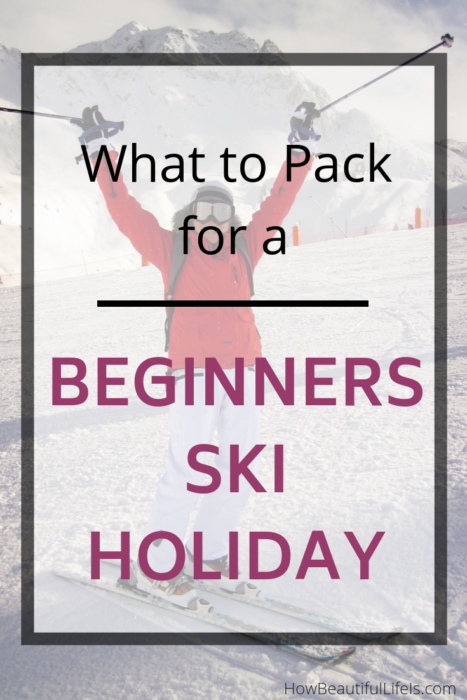




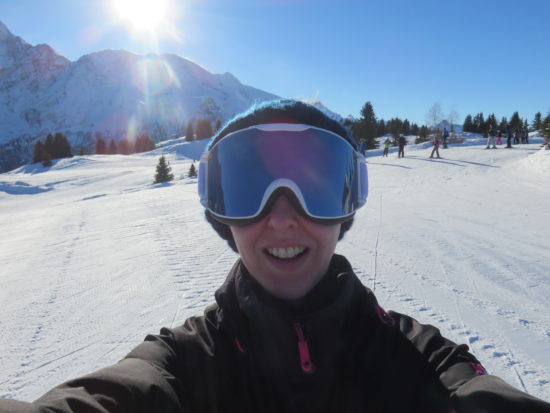

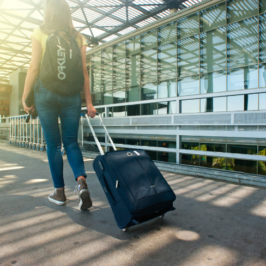
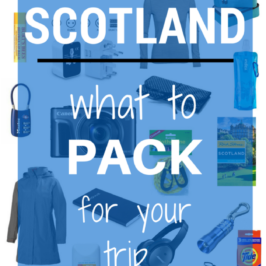
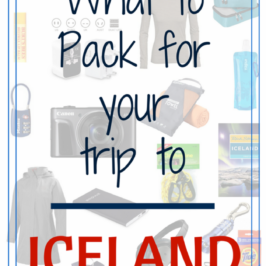

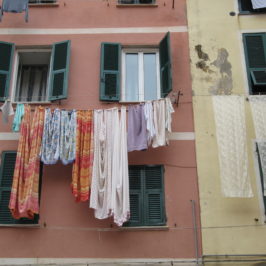
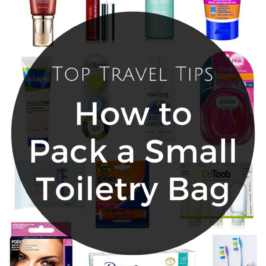
Leave a Reply